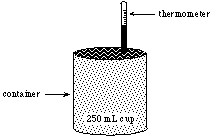 |
 |
|
|
|
|
Welcome to this experimental science test. We hope that you will
find it interesting and worthwhile. Carefully read through these
directions and the directions on the next page before you begin
to work. You may be part of a group for the first part of this exercise.
Each group should carry out the experiment and collect the data
together, but each student must record the data in his or her own
booklet. Be sure to record the data exactly as you observe them.
After the data have been collected, each student should answer the
questions independently. After you have finished your experiment and have recorded all
of the data, you will be asked to answer some questions about the
experiment and the data you recorded. Your answers must be written
in this test booklet in the space provided. Make sure that you understand
each question before you begin to write. At any time while you are
writing your answers, you may look back at the directions for the
experiment and the data you collected. Be sure that your answers
are written as clearly and neatly as possible. Before you turn the page, read the list of materials
given below and check to make sure that your group has everything
listed.
Heat Storage You and your lab team have been hired by a group of architects
to help them design a solar home. The architects have asked you
to help them select the material that will be used as the heat
mass. The heat mass is a large amount of material, usually in
a wall or on the roof, that is efficient in converting sunlight
into heat energy. The heat energy is stored in the wall and then
slowly reradiated into the home during the cool evening hours. The
architects have asked your lab team to test the following materials:
water, sand, gravel, and Styrofoam. You will conduct the tests as
a group but each member of the group will individually record and
analyze the data and make a recommendation to the architects. You will be working with three other students to collect data.
Each member of the team will collect data for a different material:
water, sand, gravel, or Styrofoam. Each student must record the
data for all four materials in his or her own booklet. 1. Fill your 250 ml cup with one of the four substances. The material should be level with the top of the cup. 2. Insert a thermometer into the material. The thermometer will
remain in the material throughout the experiment. DO NOT REMOVE
IT! The thermometer's mercury or alcohol level must extend above
the material, so that you can read the temperature during the experiment,
as shown in Figure 1 below. DO NOT TURN ON THE LAMP!

3. Each cup should be placed on one of the Xs that is marked on the workbench. The four Xs are the same distance from the bulb. The bulb should be about 30 cm above the table top. 4. Measure and record the temperature of your material (the initial temperature) in Table 1. (Note: Each thermometer in the four cups should be pushed down to the same depth). 5. Turn on the bulb and leave it on for 10 minutes. 6. After 10 minutes, turn off the bulb and immediately record the temperature inside your cup. This temperature will be designated T0. 7. Allow each of the materials to cool naturally. Two minutes after the lamp is turned off, measure the temperature (T2) and record it in Table 1. To obtain temperatures T4, T6, T8, and T10, record the temperatures every 2 minutes after the lamp is off. This should take 10 minutes. 8. Each member of the group must record the data in his or her own booklet.
Questions Please answer the following questions by yourself. 1. Using a different colored pencil for the graph of each material, plot the data for water, gravel, sand, and Styrofoam. If you do not have colored pencils, use different kinds of lines, e.g., dashes, dots, or squares, for each graph (- - - - n n n n H H H H s s s s).
 2. How many degrees (°C) did each substance cool during the 10-minute cool down period? Water: _____________ ; Sand: _____________ ; Gravel: _____________ ; Styrofoam: _____________ Which material cooled the fastest? __________________________________________________________ Which material cooled the slowest? _________________________________________________________
3. Based on the data, which material would you recommend
for use as the heat mass of this solar home? Explain to the architect
why you have selected this material. |